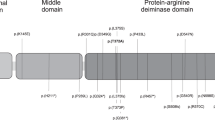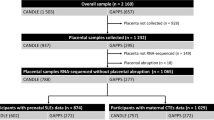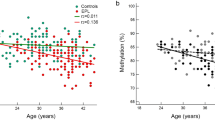Abstract
It has been shown previously that homozygous and compound-heterozygous variants affecting protein function in the human NLRP genes impact reproduction and/or fetal imprinting patterns. These variants represent so-called ‘maternal effect mutations’, that is, although female variant carriers are healthy, they are at risk of reproductive failure, and their offspring may develop aberrant methylation and imprinting disorders. In contrast, the relevance to reproductive failure of maternal heterozygous NLRP7 variants remains unclear. The present report describes the identification of a heterozygous NLRP7 variant in a healthy 28-year-old woman with a history of recurrent reproductive failure, and the molecular findings in two of the deceased offspring. Next-generation sequencing (NGS) for NLRP variants was performed. In the tissues of two offspring (one fetus; one deceased premature neonate) methylation of imprinted loci was tested using methylation-specific assays. Both pregnancies had been characterized by the presence of elevated human chorionic gonadotropin (hCG) levels and ovarian cysts. In the mother, a heterozygous nonsense 2-bp deletion in exon 5 of the NLRP7 gene was identified (NM_001127255.1:c.2010_2011del, p.(Phe671Glnfs*18)). In the two investigated offspring, heterogeneous aberrant methylation patterns were detected at imprinted loci. The present data support the hypothesis that heterozygous NLRP7 variants contribute to reproductive wastage, and that these variants represent autosomal dominant maternal effect variants which lead to aberrant imprinting marks in the offspring. Specific screening and close prenatal monitoring of NLRP7 variant carriers is proposed. Egg donation might facilitate successful pregnancy in heterozygous NLRP7 variant carriers.
Similar content being viewed by others
Log in or create a free account to read this content
Gain free access to this article, as well as selected content from this journal and more on nature.com
or
References
Broz P, Monack DM : Newly described pattern recognition receptors team up against intracellular pathogens. Nat Rev Immunol 2013; 13: 551–565.
Van Gorp H, Kuchmiy A, Van Hauwermeiren F, Lamkanfi M : NOD-like receptors interfacing the immune and reproductive systems. FEBS J 2014; 281: 4568–4582.
Meyer E, Lim D, Pasha S et al: Germline mutation in NLRP2 (NALP2) in a familial imprinting disorder (Beckwith-Wiedemann Syndrome). PLoS Genet 2009; 5: e1000423–e1000423.
Docherty LE, Rezwan FI, Poole RL et al: Mutations in NLRP5 are associated with reproductive wastage and multilocus imprinting disorders in humans. Nat Commun 2015; 6: 8086.
Murdoch S, Djuric U, Mazhar B et al: Mutations in NALP7 cause recurrent hydatidiform moles and reproductive wastage in humans. Nat Genet 2006; 38: 300–302.
Caliebe A, Richter J, Ammerpohl O et al: A familial disorder of altered DNA-methylation. J Med Genet 2014; 51: 407–412.
Messaed C, Chebaro W, Roberto RBD et al: NLRP7 in the spectrum of reproductive wastage: rare non-synonymous variants confer genetic susceptibility to recurrent reproductive wastage. J Med Genet 2011; 48: 540–548.
Landolsi H, Rittore C, Philibert L et al: Screening for NLRP7 mutations in familial and sporadic recurrent hydatidiform moles: report of 2 Tunisian families. Int J Gynecol Pathol Off J Int Soc Gynecol Pathol 2011; 30: 348–353.
Landolsi H, Rittore C, Philibert L et al: NLRP7 mutation analysis in sporadic hydatidiform moles in Tunisian patients: NLRP7 and sporadic mole. Arch Pathol Lab Med 2012; 136: 646–651.
Eggermann T, Perez de Nanclares G, Maher ER et al: Imprinting disorders: a group of congenital disorders with overlapping patterns of molecular changes affecting imprinted loci. Clin Epigenetics 2015; 7: 123.
Hayward BE, De Vos M, Talati N et al: Genetic and epigenetic analysis of recurrent hydatidiform mole. Hum Mutat 2009; 30: E629–E639.
Kou YC, Shao L, Peng HH et al: A recurrent intragenic genomic duplication, other novel mutations in NLRP7 and imprinting defects in recurrent biparental hydatidiform moles. Mol Hum Reprod 2008; 14: 33–40.
Ito Y, Maehara K, Kaneki E et al: Novel nonsense mutation in the NLRP7 gene associated with recurrent hydatidiform mole. Gynecol Obstet Invest 2015; 81: 353–358.
Sanchez-Delgado M, Martin-Trujillo A, Tayama C et al: Absence of maternal methylation in biparental hydatidiform moles from women with NLRP7 maternal-effect mutations reveals widespread placenta-specific imprinting. PLoS Genet 2015; 11: e1005644.
Fallahian M, Sebire NJ, Savage PM, Seckl MJ, Fisher RA : Mutations in NLRP7 and KHDC3L confer a complete hydatidiform mole phenotype on digynic triploid conceptions. Hum Mutat 2013; 34: 301–308.
Mahadevan S, Wen S, Wan Y-W et al: NLRP7 affects trophoblast lineage differentiation, binds to overexpressed YY1 and alters CpG methylation. Hum Mol Genet 2014; 23: 706–716.
Akoury E, Gupta N, Bagga R et al: Live births in women with recurrent hydatidiform mole and two NLRP7 mutations. Reprod Biomed Online 2015; 31: 120–124.
Deveault C, Qian JH, Chebaro W et al: NLRP7 mutations in women with diploid androgenetic and triploid moles: a proposed mechanism for mole formation. Hum Mol Genet 2009; 18: 888–897.
Qian J, Deveault C, Bagga R, Xie X, Slim R : Women heterozygous for NALP7/NLRP7 mutations are at risk for reproductive wastage: report of two novel mutations. Hum Mutat 2007; 28: 741–741.
Slim R, Wallace EP : NLRP7 and the genetics of hydatidiform moles: recent advances and new challenges. Front Immunol 2013; 4: 242.
Begemann M, Leisten I, Soellner L, Zerres K, Eggermann T, Spengler S : Use of multilocus methylation-specific single nucleotide primer extension (MS-SNuPE) technology in diagnostic testing for human imprinted loci. Epigenetics 2012; 7: 473–481.
Slim R, Bagga R, Chebaro W, Srinivasan R, Agarwal N : A strong founder effect for two NLRP7 mutations in the Indian population: an intriguing observation. Clin Genet 2009; 76: 292–295.
Beygo J, Ammerpohl O, Gritzan D et al: Deep bisulfite sequencing of aberrantly methylated loci in a patient with multiple methylation defects. PLoS One 2013; 8: e76953.
Eggermann T, Brioude F, Russo S et al: Prenatal molecular testing for Beckwith-Wiedemann and Silver-Russell syndromes: a challenge for molecular analysis and genetic counseling. Eur J Hum Genet 2015; 24: 784–793.
Akoury E, Zhang L, Ao A, Slim R : NLRP7 and KHDC3L, the two maternal-effect proteins responsible for recurrent hydatidiform moles, co-localize to the oocyte cytoskeleton. Hum Reprod 2015; 30: 159–169.
Acknowledgements
We thank the patient and her family for their cooperation. LS, MB and TE are supported by the German Federal Ministry of Education and Research (Network ‘Imprinting Diseases’; 01GM1513B). They are members of the COST Action BM1208 and EUCID.net (European Congenital Imprinting Disorders Network; www.imprinting-disorders.eu). The NGS facility is funded by the Deutsche Forschungsgemeinschaft DFG (INST948/32-1FUGG).
Author information
Authors and Affiliations
Corresponding author
Ethics declarations
Competing interests
The authors declare no conflict of interest.
Additional information
Supplementary Information accompanies this paper on European Journal of Human Genetics website
Supplementary information
Rights and permissions
About this article
Cite this article
Soellner, L., Begemann, M., Degenhardt, F. et al. Maternal heterozygous NLRP7 variant results in recurrent reproductive failure and imprinting disturbances in the offspring. Eur J Hum Genet 25, 924–929 (2017). https://doi.org/10.1038/ejhg.2017.94
Received:
Revised:
Accepted:
Published:
Issue date:
DOI: https://doi.org/10.1038/ejhg.2017.94
This article is cited by
-
Variants of NLRP genes encoding subcortical maternal complex components are linked to biparental placental mesenchymal dysplasia
Human Genomics (2025)
-
Multi-locus imprinting disturbance (MLID): interim joint statement for clinical and molecular diagnosis
Clinical Epigenetics (2024)
-
Imprinting disorders
Nature Reviews Disease Primers (2023)
-
Trans-acting genetic variants causing multilocus imprinting disturbance (MLID): common mechanisms and consequences
Clinical Epigenetics (2022)
-
Molecular tools for the genomic assessment of oocyte’s reproductive competence
Journal of Assisted Reproduction and Genetics (2022)



